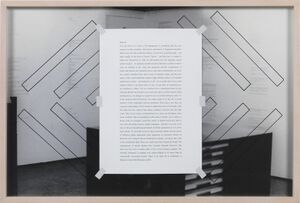Letters to the Red Crayola II, 1972-2012
| Letters to the Red Crayola II, 1972-2012 | |
|---|---|
 | |
| Art & Language | |
| Project | |
| Year | 2012 |
| Dimensions | 41.4 × 61.2 cm[1] |
| Materials | Ink, acrylic, collage and mixed media on paper |
Text
Dear M, You say that we've been a bit intemperate in remarking that the new curators are the secondary and tertiary consumers of fragments that have fallen away from the academic milieux of art history and philosophy — the latter usually in the form of French Theory—and that they've tended to rediscover themselves in what we did indeed call 'the absurdly named cultural studies'. An audience member declared that these cultural workers were not deluded at all: 'since the categories and the competences of artists and curators are mutually porous, and since contemporary art is not now readily detached from many forms of popular culture and the new media of the visual-industrial complex, then cultural studies is of essential significance to them—and indeed to us all'. As we really don't know what cultural studies is, let alone what it is for, we can offer no comment as to its usefulness to others. For us it seems to be a complicated kind of easy listening that has been made to act coercively upon a certain section of the intelligentsia, even though its origins lie in a lot of discontinuous noise. As to the curators and art historians who make much of it. they do so in the interests of the corporation and the institution. Knowing or not, they are corporate cheerleaders. We're bound to admit that some of our early work fits tidily into the cultural and artistic templates issued in the last fifty years. That is not a source of satisfaction to us, more one of sadness and a sense of defeat. But in responding to that sense of defeat, we've often (or always) put on a disguise: acted like artists. It should not be any kind of news that all artistic practice entails imposture. And this is as true if not truer of the psychopathological branch of artistic production as it is of the most urbane. It's possible, however, that an artistic culture with the power of deflation might understand some imposture as necessary fiction, its discovery not a disaster but an incitement to inquiry. For those who work in the institutional light, discovery might once have ruined the brand. The requirements of artistic identity have recently changed, however. The artist can now feel a certain pride in his or her business acumen. The romantic stereotype is perhaps now acknowledged as no more than an occasionally convenient fiction. There is no need for it completely to disguise a mean little Rotarian profile.
Interpretations
- The background is a photo of Index 01 (1972)